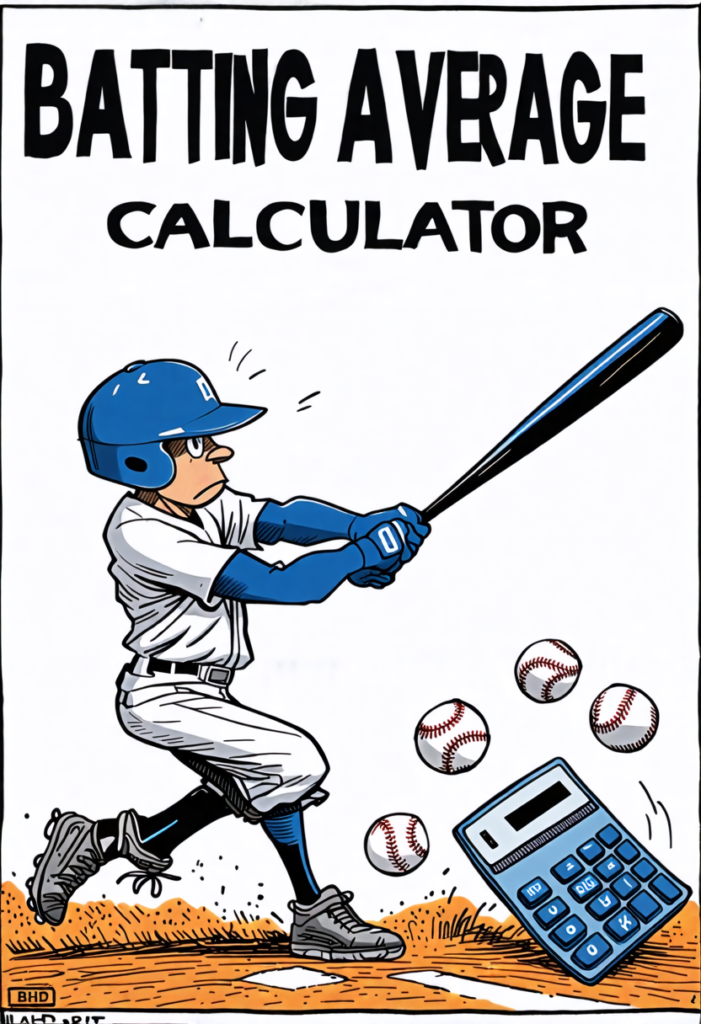Batting Average Calculator
Whether you are a cricket player or a baseball superstar, batting average is important.
This batting average calculator allows you to calculate your cricket batting and baseball batting averages.
If you choose to find your cricket batting average, enter your runs scored and the number of times you have been out.
If you choose baseball, you need to enter the number of hits and at bats.

You might want to calculate your fielding, bowling, handicap bowling, or run rates.
What is a Batting Average?
Before we delve into the calculator itself, it’s important to understand what a batting average represents. In simple terms, a batting average is a statistic used to measure a player’s hitting performance. It’s calculated by dividing the number of hits a player gets by the number of times they bat. This results in a decimal number that represents the player’s success rate at the plate.
Batting Average in Baseball
In baseball, the batting average is one of the most commonly cited statistics. It’s used to evaluate a batter’s skill and consistency at the plate. The batting average in baseball is typically expressed as a three-digit decimal number. For example, a batting average of .300 (pronounced “three hundred”) means that the player gets a hit 30% of the time they bat.
Batting Average in Cricket
Cricket also uses batting averages, but the calculation and interpretation differ slightly from baseball. In cricket, the batting average is calculated by dividing the total number of runs scored by the number of times the batsman has been dismissed. This results in a number that represents the average number of runs a player scores per innings.
How to Calculate Batting Average?
The formula for calculating batting average is straightforward, but it can be time-consuming to compute manually, especially when dealing with large datasets or multiple players. This is where a batting average calculator comes in handy.
Baseball Batting Average Formula
In baseball, the formula is:
Batting Average = Number of Hits / Number of At-Bats
It’s important to note that certain plate appearances, such as walks, sacrifices, and hit-by-pitches, are not counted as at-bats.
Cricket Batting Average Formula
For cricket, the formula is:
Batting Average = Total Runs Scored / Number of Times Dismissed
Using the Batting Average Calculator
Our batting average calculator is designed to be user-friendly and versatile, accommodating both baseball and cricket calculations. Here’s how to use it:
- Select your sport (baseball or cricket) from the dropdown menu.
- For baseball:
- Enter the number of hits in the “Hits” field.
- Enter the number of at-bats in the “At Bats” field.
- For cricket:
- Enter the total runs scored in the “Scored Runs” field.
- Enter the number of times dismissed in the “Times Out” field.
- Click the “Calculate” button.
- The calculator will display the batting average, rounded to three decimal places for baseball or two decimal places for cricket.
Interpreting Batting Averages
Understanding what a batting average means is just as important as knowing how to calculate it. Let’s look at how to interpret these numbers in both baseball and cricket.
Baseball Batting Average Interpretation
In baseball, batting averages typically range from .200 to .300, with .300 considered excellent. Here’s a general guide:
- .300 and above: Excellent
- .275 to .299: Very good
- .250 to .274: Average
- .225 to .249: Below average
- Below .225: Poor
It’s worth noting that a .400 batting average for a season is considered exceptional and hasn’t been achieved in Major League Baseball since Ted Williams hit .406 in 1941.
Cricket Batting Average Interpretation
In cricket, batting averages can vary widely depending on the format of the game (Test, One Day International, or Twenty20) and the player’s role. Generally:
- 50 and above: Excellent (for Test cricket)
- 40 to 49: Very good
- 30 to 39: Good
- 20 to 29: Average
- Below 20: Below average
Top international batsmen often have Test batting averages in the 50s or even 60s.
Benefits of Using a Batting Average Calculator
Employing a batting average calculator offers several advantages:
- Accuracy: Manual calculations can be prone to errors, especially when dealing with large numbers. A calculator ensures precise results every time.
- Time-saving: Computing batting averages for multiple players or over an entire season can be time-consuming. A calculator streamlines this process significantly.
- Consistency: Using a standardized tool ensures that all calculations are performed the same way, allowing for fair comparisons between players.
- Accessibility: Our online calculator is available anytime, anywhere, making it easy for players, coaches, and fans to quickly compute batting averages.
- Educational value: For those new to the sport, using a calculator can help reinforce the concept of batting averages and how they’re computed.
Other Important Baseball and Cricket Statistics
While the batting average is a crucial statistic, it’s not the only measure of a player’s offensive performance. Here are some other important statistics used in baseball and cricket:
Baseball Statistics
- On-Base Percentage (OBP): This measures how often a batter reaches base, including walks and hit-by-pitches.
- Slugging Percentage: This statistic takes into account the quality of hits, giving more weight to extra-base hits.
- On-Base Plus Slugging (OPS): This combines OBP and slugging percentage for a more comprehensive offensive metric.
- Runs Batted In (RBI): This counts the number of runs a player drives in with their hits.
Cricket Statistics
- Strike Rate: This measures the number of runs scored per 100 balls faced, indicating how quickly a batsman scores runs.
- Centuries: The number of innings where a batsman scores 100 runs or more.
- Half-centuries: The number of innings where a batsman scores 50-99 runs.
- Highest Score: The highest number of runs scored by a batsman in a single innings.
The Importance of Batting Average in Player Evaluation
Batting average has been a cornerstone of player evaluation in both baseball and cricket for over a century. It provides a simple, easy-to-understand measure of a player’s hitting ability. However, it’s important to note that while batting average is valuable, it shouldn’t be the only factor considered when evaluating a player’s performance.
In baseball, for instance, a player with a high batting average but low power numbers might be less valuable than a player with a slightly lower average but more extra-base hits. Similarly, in cricket, a player with a high average but low strike rate might not be as effective in limited-overs formats where scoring quickly is crucial.
Coaches, scouts, and team managers use batting average in conjunction with other statistics and observational data to get a comprehensive picture of a player’s abilities and potential.
Historical Context of Batting Averages
The concept of batting average has been around almost as long as organized baseball itself. In the early days of the sport, batting average was one of the few statistics regularly tracked and reported. It quickly became the primary measure of a hitter’s success.
In cricket, batting averages have been recorded since the sport’s early days in the 18th century. The statistic gained prominence in the late 19th century as cricket became more organized and standardized.
Over time, as our understanding of sports analytics has evolved, new statistics have been developed to complement batting average. However, its simplicity and long history ensure that batting average remains a fundamental statistic in both sports.






